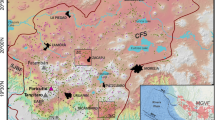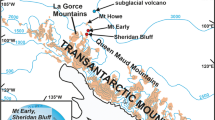Abstract
New eruptions in monogenetic volcanic fields conceptually occur independently of previous ones. In some instances, however, younger volcanic structures and vents may overlap with older edifices. The genetic links between such co-located eruptions remain unclear. We mapped and analysed the stratigraphic relationships between eruptive units on the 400 × 900-m island of Chagwido off the western coast of Jeju Island, a Pleistocene to Holocene intraplate volcanic field. Chagwido consists of an eastern, older tuff ring with a nested scoria cone and a western tuff, scoria and lava flow sequence. The two stratigraphic packages are separated by a prominent paleosol. The East-Chagwido tuff and scoria deposits were eroded and a period of intense weathering and soil development occurred, before a subsequent West-Chagwido tuff ring and scoria cone and lava complex was erupted. The two eruptions were fed by three chemically distinct magmas. The older eastern eruption consists of magma with composition transitional between high-Al alkalic basalt and low-Al alkalic basalt and has stratigraphic characteristics, composition and syn-eruptive trends akin to the neighbouring Dangsanbong tuff cone. This magma type is typical for the transitional stage from high-Al alkalic (pre 500 ka) to low-Al alkalic (post 250 ka) identified for the greater Jeju volcanic system. The East-Chagwido volcanic complex thus formed as the westernmost in a chain of three volcanoes along a fissure system, with a small volcanic remnant island Wado 1 km to the east and the large Dangsanbong tuff cone another 1 km eastward. A new Ar/Ar age of 446 ± 22 ka for Dangsanbong likely characterizes the age of the whole chain. The second, West-Chagwido eruption started with low-Al alkalic basalt forming a phreatomagmatic phase and ended with subalkalic basalt forming a scoria cone and lava flows. The occurrence of subalkalic lavas is known across Jeju to have started only at ~250 ka, and thus, the well-developed paleosol represents at least 200 kyr between the two co-located eruptions. The distinctive magma compositions show that each eruption tapped an independent region within the same underlying mantle source. These observations show that contrary to most assumptions of monogenetic volcanism, an already “tapped” source region may become fertile again through mantle convection/migration and eruptions can thus be expected from old vent sites in long-lived volcanic fields.








Similar content being viewed by others
References
Bebbington MS, Cronin SJ (2011) Spatio-temporal hazard estimation in the Auckland Volcanic Field, New Zealand, with a new event-order model. Bull Volcanol 73:55–72
Brenna M (2012) Geological evolution and magmatic models for spatially and temporally variable modes of distributed volcanism, Jeju Island, Republic of Korea. PhD Thesis, Massey University
Brenna M, Cronin SJ, Smith IEM, Sohn YK, Németh K (2010) Mechanisms driving polymagmatic activity at a monogenetic volcano, Udo, Jeju Island, South Korea. Contrib Mineral Petrol 160:931–950. doi:10.1007/s00410-010-0515-1
Brenna M, Cronin SJ, Németh K, Smith IEM, Sohn YK (2011) The influence of magma plumbing complexity on monogenetic eruptions, Jeju Island, Korea. Terra Nov. 23:70–75. doi:10.1111/j.1365-3121.2010.00985.x
Brenna M, Cronin SJ, Smith IEM, Maas R, Sohn YK (2012a) How small-volume basaltic magmatic systems develop: a case study from the Jeju Island Volcanic Field, Korea. J Petrol 53:985–1018. doi:10.1093/petrology/egs007
Brenna M, Cronin SJ, Smith IEM, Sohn YK, Maas R (2012b) Spatio-temporal evolution of a dispersed magmatic system and its implications for volcano growth, Jeju Island Volcanic Field, Korea. Lithos 148:337–352. doi:10.1016/j.lithos.2012.06.021
Brenna M, Cronin S, Kereszturi G, Sohn Y, Smith IM, Wijbrans J (2015) Intraplate volcanism influenced by distal subduction tectonics at Jeju Island, Republic of Korea. Bull Volcanol 77:1–16. doi:10.1007/s00445-014-0896-5
Briggs RM, Okada T, Itaya T, Shibuya H, Smith IEM (1994) K-Ar ages, paleomagnetism, and geochemistry of the South Auckland volcanic field, North Island, New Zealand. New Zealand J Geol Geophys 37:143–153
Condit CD, Connor CB (1996) Recurrence rates of volcanism in basaltic volcanic fields: an example from the Spingerville volcanic field, Arizona. Geol Soc Am Bull 108:1225–1241
Connor CB, Hill BE (1995) Three nonhomogeneous Poisson models for the probability of basaltic volcanism: application to the Yucca Mountain region, Nevada. J Geophys Res 100:10107–10125
Cook C, Briggs RM, Smith IEM, Maas R (2005) Petrology and geochemistry of intraplate basalts in the South Auckland Volcanic Field, New Zealand: evidence for two coeval magma suites from distinct sources. J Petrol 46:473–503. doi:10.1093/petrology/egh084
Eggins SM, Rudnick RL, McDonough WF (1998) The composition of peridotites and their minerals: a laser-ablation ICP–MS study. Earth Planet Scie Lett 154:53–71. doi:10.1016/s0012-821x(97)00195-7
Irvine T, Baragar W (1971) A guide to the chemical classification of the common volcanic rocks. Canad J Earth Scie 8:523–548
Jankovics MÉ, Harangi S, Kiss B, Ntaflos T (2012) Open-system evolution of the Füzes-tó alkaline basaltic magma, western Pannonian Basin: constraints from mineral textures and compositions. Lithos 140:25–37
Kereszturi G, Németh K, Cronin SJ, Agustín-Flores J, Smith IEM, Lindsay J (2013) A model for calculating eruptive volumes for monogenetic volcanoes—implication for the quaternary Auckland Volcanic Field, New Zealand. J Volcanol Geotherm Res 266:16–33. doi:10.1016/j.jvolgeores.2013.09.003
Kiyosugi K, Connor CB, Zhao D, Connor LJ, Tanaka K (2010) Relationships between volcano distribution, crustal structure, and P-wave tomography: an example from the Abu Monogenetic Volcano Group, SW Japan. Bull Volcanol 72:331–340. doi:10.1007/s00445-009-0316-4
Koh GW, Park JB, Kang B-R, Kim G-P, Moon DC (2013) Volcanism in Jeju Island. J Geol Soc Korea 49:209–230
Koppers AAP (2002) ArArCALC—software for Ar-40/Ar-39 age calculations. Computers Geoscie 28:605–619. doi:10.1016/S0098-3004(01)00095-4
Kuiper KF, Deino A, Hilgen FJ, Krijgsman W, Renne PR, Wijbrans JR (2008) Synchronizing rock clocks of Earth history. Science 320:500–504. doi:10.1126/ science.1154339
Le Corvec N, Bebbington MS, Lindsay JM, McGee LE (2013a) Age, distance, and geochemical evolution within a monogenetic volcanic field: analyzing patterns in the Auckland Volcanic Field eruption sequence. Geochem Geophys Geosys 14:3648–3665. doi:10.1002/ggge.20223
Le Corvec N, Spörli KB, Rowland J, Lindsay J (2013b) Spatial distribution and alignments of volcanic centers: clues to the formation of monogenetic volcanic fields. Earth Sci Rev 124:96–114. doi:10.1016/j.earscirev.2013.05.005
LeBas MJ, Lemaitre RW, Streckeisen A, Zanettin B (1986) A chemical classification of volcanic rocks based on the total alkali-silica diagram. J Petrol 27:745–750
Lee K, Yang WS (2006) Historical seismicity of Korea. Bull Seismol Soc Am 96:846–855. doi:10.1785/0120050050
Lisiecki LE, Raymo ME (2005) A pliocene-pleistocene stack of 57 globally distributed benthic δ18O records. Paleoceanography 20, PA1003. doi:10.1029/2004pa001071
Liu J, Carlson RW, Rudnick RL, Walker RJ, Gao S, Wu F-y (2012) Comparative Sr–Nd–Hf–Os–Pb isotope systematics of xenolithic peridotites from Yangyuan, North China Craton: additional evidence for a Paleoproterozoic age. Chem Geol 332–333:1–14. doi: http://dx.doi.org/10.1016/j.chemgeo.2012.09.013
Lynch DJ, Musselman TE, Gutmann JT, Patchett PJ (1993) Isotopic evidence for the origin of Cenozoic volcanic rocks in the Pinacate volcanic field, northwestern Mexico. Lithos 29:295–302
Mazzarini F, D'Orazio M (2003) Spatial distribution of cones and satellite-detected lineaments in the Pali Aike Volcanic Field (southernmost Patagonia): insights into the tectonic setting of a Neogene rift system. J Volcanol Geotherm Res 125:291–305
McGee LE, Beier C, Smith IEM, Turner SP (2011) Dynamics of melting beneath a small-scale basaltic system: a U-Th-Ra study from Rangitoto volcano, Auckland volcanic field, New Zealand. Contrib Mineral Petrol 162:547–563
McGee LE, Millet M-A, Smith IEM, Németh K, Lindsay JM (2012) The inception and progression of melting in a monogenetic eruption: Motukorea Volcano, the Auckland Volcanic Field, New Zealand. Lithos 155:360–374. doi:10.1016/j.lithos.2012.09.012
McGee LE, Smith IEM, Millet M-A, Handley HK, Lindsay JM (2013) Asthenospheric control of melting processes in a monogenetic basaltic system: a case study of the Auckland Volcanic Field, New Zealand. J Petrol. doi:10.1093/petrology/egt043
Moorhouse BL, White JDL, Scott JM (2015) Cape Wanbrow: a stack of Surtseyan-style volcanoes built over millions of years in the Waiareka-Deborah Volcanic Field, New Zealand. J Volcanol Geotherm Res. doi:10.1016/j.jvolgeores.2015.03.019
Needham AJ, Lindsay JM, Smith IEM, Augustinus P, Shane PA (2011) Sequential eruption of alkaline and sub-alkaline magmas from a small monogenetic volcano in the Auckland Volcanic Field, New Zealand. J Volcanol Geotherm Res 201:126–142
Németh K (2012) Monogenetic volcanic fields: origin, sedimentary record, and relationship with polygenetic volcanism. In: Cañón-Tapia E, Szakács A (eds) What is a Volcano? Geological Society of America Special Paper 470, 443–466
Norrish K, Hutton JT (1969) An accurate X-ray spectrographic method for the analysis of a wide range of geological samples. Geochim Cosmochim Acta 33:431–453. doi:10.1016/0016-7037(69)90126-4
Petrelli M, Poli G, Perugini D, Peccerillo A (2005) PetroGraph: a new software to visualize, model, and present geochemical data in igneous petrology. Geochem Geophys Geosys (G3) 6, Q07011. doi:10.1029/2005GC000932
Renne PR et al (2009) Data reporting norms for 40Ar/39Ar geochronology. Quatern Geochronol 4:346–352. doi:10.1016/j.quageo.2009.06.005
Schneider B, Kuiper K, Postma O, Wijbrans J (2009) 40Ar/39Ar geochronology using a quadrupole mass spectrometer. Quatern Geochronol 4:508–516. doi:10.1016/j.quageo.2009.08.003
Smith IEM, Blake S, Wilson CJN, Houghton BF (2008) Deep-seated fractionation during the rise of a small-volume basalt magma batch: Crater Hill, Auckland, New Zealand. Contrib Mineral Petrol 155:511–527
Sohn YK, Park KH (2005) Composite tuff ring/cone complexes in Jeju Island, Korea: possible consequence of substrate collapse and vent migration. J Volcanol Geotherm Res 141:157–175
Sohn YK, Park KH, Yoon SH (2008) Primary versus secondary and subaerial versus submarine hydrovolcanic deposits in the subsurface of Jeju Island, Korea. Sedimentology 55:899–924
Sohn YK, Cronin SJ, Brenna M, Smith IEM, Németh K, White JDL, Murtagh RM, Jeon YM, Kwon CW (2012) Ilchulbong tuff cone, Jeju Island, Korea, revisited: a compound monogenetic volcano involving multiple magma pulses, shifting vents, and discrete eruptive phases. Geol Soc Am Bull 124:259–274. doi:10.1130/b30447.1
Sudo M, Uto K, Tatsumi Y, Matsui K (1998) K-Ar geochronology of a Quaternary monogenetic volcano group in Ojika Jima District, Southwest Japan. Bull Volcanol 60:171–186
Sun SS, McDonough WF (1989) Chemical and isotopic systematics of oceanic basalts: implications for mantle composition and processes. In: Saunders AD, Norry MJ (eds) Magmatism in the Ocean Basins. Geological society special publication, vol 42. Geological Society, London, pp 313–345
Tatsumi Y, Shukuno H, Yoshikawa M, Chang Q, Sato K, Lee MW (2005) The petrology and geochemistry of volcanic rocks on Jeju Island: plume magmatism along the Asian continental margin. J Petrol 46:523–553. doi:10.1093/petrology/egh087
Valentine GA, Hirano N (2010) Mechanisms of low-flux intraplate volcanic fields–Basin and Range (North America) and northwest Pacific Ocean. Geology 38:55–58. doi:10.1130/g30427.1
Valentine GA, Perry FV (2006) Decreasing magmatic footprints of individual volcanoes in a waning basaltic field. Geophys Res Lett 33, L14305. doi:10.1029/2006GL026743
Valentine GA, Perry FV (2007) Tectonically controlled, time-predictable basaltic volcanism from a lithospheric mantle source (central Basin and Range Province, USA). Earth Planet Scie Lett 261:201–216
van Otterloo J, Cas RAF, Sheard MJ (2013) Eruption processes and deposit characteristics at the monogenetic Mt. Gambier Volcanic Complex, SE Australia: implications for alternating magmatic and phreatomagmatic activity. Bull Volcanol 75:1–21. doi:10.1007/s00445-013-0737-y
Xiao L, Wang C (2009) Geologic features of Wudalianchi volcanic field, northeastern China: implications for Martian volcanology. Planet Space Scie 57:685–698. doi:10.1016/j.pss.2008.08.005
Zou H, Fan Q, Yao Y (2008) U-Th systematics of dispersed young volcanoes in NE China: asthenosphere upwelling caused by piling up and upward thickening of stagnant Pacific slab. Chem Geol 255:134–142
Acknowledgments
SJC and IEMS are grateful for support from NZ Ministry of Science and Innovation (formerly FRST) project MAUX0808 “Facing the challenge of Auckland volcanism”. MB was also supported by a Massey University Vice-Chancellor’s Scholarship and YKS by a National Research Foundation of Korea (NRF) grant (No. 2009–0079427). Editor David Peate and an anonymous reviewer provided helpful comments to improve the manuscript.
Author information
Authors and Affiliations
Corresponding author
Additional information
Editorial responsibility: D.W. Peate
Electronic supplementary material
Below is the link to the electronic supplementary material.
Electronic Appendix 1
(XLS 32 kb)
Electronic Appendix 2
(PDF 57 kb)
Rights and permissions
About this article
Cite this article
Brenna, M., Németh, K., Cronin, S.J. et al. Co-located monogenetic eruptions ~200 kyr apart driven by tapping vertically separated mantle source regions, Chagwido, Jeju Island, Republic of Korea. Bull Volcanol 77, 43 (2015). https://doi.org/10.1007/s00445-015-0928-9
Received:
Accepted:
Published:
DOI: https://doi.org/10.1007/s00445-015-0928-9




